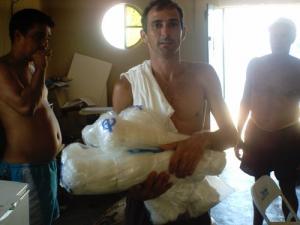Note: Forty-two years ago today, US National Guardsmen opened fire on unarmed students at Kent State University who were protesting the Vietnam War and its expansion into neighboring Cambodia. Four were killed and nine wounded. Justice has never been served to the victims of this atrocity.
Four decades later, the US is sending men and women overseas to fight wars for oil at the same time that the very life-support systems of the planet are on the verge of a complete meltdown from fossil fuel-induced global warming and its resulting climate chaos. These wars enable the 1% to continue their grossly unsustainable lives of privilege at the expense of the rest.
After the Kent State massacre, students rose up across the country. Hundreds of colleges and universities were shut down by student protests and outrage.
Today the stakes are higher than ever. Can we share and learn from the experiences of the movements from the 1960s and encourage a new era of global direct action–a new era of outrage?
The 1% will not change with niceties, permitted marches or orchestrated mass-arrests. They will not change through the corporate-owned electoral process. As Frederick Douglass pointed out:
“Power concedes nothing without a demand. It never did and it never will. Find out just what any people will quietly submit to and you have found out the exact measure of injustice and wrong which will be imposed upon them, and these will continue till they are resisted with either words or blows, or both. The limits of tyrants are prescribed by the endurance of those whom they oppress.”
I would add to this that it is not enough merely to demand. The demands must be backed up by action: action in the form of general strikes, student shut downs and the total obstruction of business as usual. After all, it is literally our future that is at stake.
–Anne Petermann for the GJEP Team
Cross-Posted from Reuters
By Kim Palmer
KENT, Ohio | Thu May 3, 2012 11:23pm EDT
(Reuters) – Survivors of the shooting of 13 students by the Ohio National Guard during an anti-war demonstration at Kent State University in 1970 called on Thursday for a new probe into the incident that came to define U.S. divisions over the Vietnam War.
Four students were killed and nine wounded in the shootings on May 4, 1970 that followed days of demonstrations on the campus after disclosures of a U.S.-led invasion of Cambodia that signaled a widening of the war in Southeast Asia.
Kent State was shut for weeks after the shootings and student strikes closed down schools across the nation.
On the eve of the 42nd anniversary of the shootings, four students wounded that day asked U.S. Attorney General Eric Holder to investigate digitally enhanced audio evidence they believe proves an officer ordered the guardsmen to fire on the unarmed students.
A command to fire has never been proven and guardsmen said they fired in self-defense. Criminal charges were brought against eight guardsmen, but a judge dismissed the case. Wounded students and families of those slain later received a total of $675,000 after civil lawsuits.
The shootings also spawned an investigative commission, numerous books and Neil Young’s song, “Ohio,” which became an anti-war anthem. A Pulitzer Prize-winning photograph of a teenage girl kneeling over the body of one of the slain students became an enduring image of the tragedy.
In 2010, Alan Canfora, one of the wounded students and director of the nonprofit Kent May 4 Center, asked the Justice Department to review the enhanced recording, which was taken 250 feet from the guardsmen when they fired their shots in 1970.
Canfora and other audio specialists say the enhanced recording shows a clear military order to fire seconds before the shooting. The troops fired 67 shots over 13 seconds.
A Justice Department official closed the matter last month, finding the recordings were still inconclusive.
Canfora, and other wounded students Dean Kahler, Thomas Grace and Joe Lewis, asked Holder on Thursday for a new probe, saying anyone involved in the shooting should be offered immunity to provide information. They asked any surviving guardsmen to come forward with information.
“I was an angry young man for a number of years,” Canfora said. “We have to work within the system. I’ve learned a lot since we were younger. I believe they were ordered to shoot us.”
Kahler, who has been paralyzed from the waist down since the shooting, told Reuters: “We want justice in a sense, to have the truth. It would be nice to know what actually happened.
If the United States does not open a new investigation, the May 4 group plans to appeal to the International Court of Justice, the U.N. Human Rights Council or the Inter-American Court of Human Rights Canfora said.
(Reporting by Kim Palmer; Editing by David Bailey and Peter Cooney)



 João Luiz Telles Penetra. Photo courtesy Front Line Defenders
João Luiz Telles Penetra. Photo courtesy Front Line Defenders